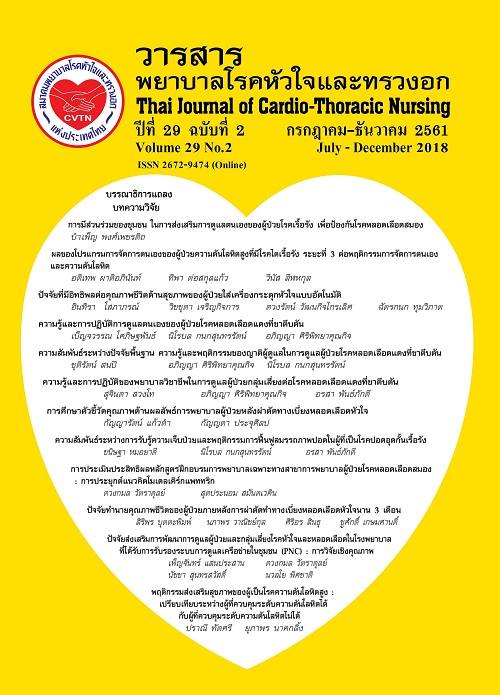ความรู้และการปฏิบัติของพยาบาลวิชาชีพในการดูแลผู้ป่วยกลุ่มเสี่ยงต่อโรคหลอดเลือดแดงที่ขาตีบตัน
คำสำคัญ:
โรคหลอดเลือดแดงที่ขาตีบตัน, ความรู้ของพยาบาล, การปฏิบัติการพยาบาล, ผู้ป่วยกลุ่มเสี่ยงต่อโรคหลอดเลือดแดงที่ขาตีบตันบทคัดย่อ
การวิจัยครั้งนี้เป็นการวิจัยเชิงบรรยายมีวัตถุประสงค์เพื่อศึกษาความรู้และการปฏิบัติของพยาบาลวิชาชีพในการดูแลผู้ป่วยกลุ่มเสี่ยงต่อโรคหลอดเลือดแดงส่วนปลายที่ขาตีบตัน (PAOD) โดยใช้กรอบแนวคิดความสามารถของพยาบาลตามทฤษฎีของโอเร็ม กลุ่มตัวอย่างเป็นพยาบาลวิชาชีพที่ปฏิบัติงานโรงพยาบาลตติยภูมิและโรงพยาบาลมหาวิทยาลัย เลือกกลุ่มตัวอย่างแบบเฉพาะเจาะจงจำนวน 136 ราย เครื่องมือที่ใช้ในการวิจัยประกอบด้วยแบบสอบถามข้อมูลส่วนบุคคล แบบสอบถามความรู้เกี่ยวกับโรค PAOD ของพยาบาล และแบบสอบถามการปฏิบัติของพยาบาลในการดูแลผู้ป่วยกลุ่มเสี่ยงต่อการเกิดโรค PAOD วิเคราะห์ข้อมูลโดยใช้สถิติบรรยาย สัมประสิทธิ์สหสัมพันธ์และสถิติไคสแควร์
ผลการวิจัยพบว่า พยาบาลผู้เข้าร่วมวิจัยมีความรู้เกี่ยวกับ PAOD ในภาพรวมระดับน้อย โดยพยาบาลมีความรู้ดีในเรื่องของสาเหตุและปัจจัยเสี่ยง แต่มีความรู้น้อยในด้านของการตรวจวินิจฉัยโรคและด้านการรักษา อาการและความรุนแรงของ PAOD สำหรับการปฏิบัติของพยาบาลเพื่อป้องกันโรคหลอดเลือดแดงส่วนปลายที่ขาตีบตันพบว่าพยาบาลประเมินตนเองว่ามีการปฏิบัติในระดับปานกลาง เมื่อแยกรายด้านพบว่าพยาบาลรับรู้ว่าได้ทำการคัดกรองร้อยละ 60 แต่มีการให้ความรู้หรือการปฏิบัติตัวกับผู้ป่วย PAOD เพียงร้อยละ 50 ปัจจัยด้านอายุ ระดับการศึกษา ประสบการณ์การดูแลผู้ป่วย PAOD ระยะเวลาในการปฏิบัติงาน การอบรมเพิ่มเติมของพยาบาลไม่มีความสัมพันธ์กับการปฏิบัติของพยาบาลในการดูแลผู้ป่วยโรค PAOD ความรู้เกี่ยวกับโรค PAOD ของพยาบาลมีความสัมพันธ์ทางบวกกับการปฏิบัติของพยาบาลในการดูแลผู้ป่วย PAOD และแผนกที่ปฏิบัติงานของพยาบาลมีความสัมพันธ์กับการปฏิบัติการพยาบาล อย่างมีนัยสำคัญทางสถิติ
จากผลการวิจัยพบว่าพยาบาลมีความรู้เรื่องโรค PAOD น้อย จึงควรมีการส่งเสริมความรู้ของพยาบาล เพื่อให้พยาบาลสามารถพัฒนาทักษะในเรื่อง การคัดกรอง การให้ความรู้และคำแนะนำในการปฏิบัติตนของผู้ป่วย PAOD ต่อไป
เอกสารอ้างอิง
2. Mutirangura P. Emergency vascular surgery. Bangkok: Aksorn sampan press (1987); 2010.
3. The American College of Cardiology Foundation and the American Heart Association, Inc [internet]. Management of patients with peripheral artery disease; 2011[update 2011 Nov; cite 2014 Dec] Available from: https://www.my. americanheart.org/idc/groups/ahamah-public/@wcm/@sop/ @spub/documents/downloadable/ucm_436821.pdf
4. Chuengsamarn S, Sangpanich A, Laoopugsin N. Prevalence and risk factors of peripheral arterial disease in type 2 diabetic patients at HRH Princess Maha Chakri Sirindhorn Medical Center. J Med Assoc Thai. 2010; 93 (Suppl 2):S32-8.
5. Institute of Medical Research and Technology Assessment, Department of Medical services. Clinical Practice Guideline: Prevention and management of diabetic foot complications. Bangkok: The Agricultural Cooperation Federation of Thailand; 2013
6. Porntisan S, Jaratjarernvitaya N, Taravanij T. The study prevalence of peripheral arterial disease in type2 diabetes in Thammasat Hospital. Thammasat medical Journal. 2008; 8: 32-9.
7. Hirsch AT, Criqui MH, Treat-Jacobson D, Regensteiner JG, Creager MA, Olin JW, et al. Peripheral arterial disease detection, awereness, and treatment in primary care. JAMA. 2001 Sep 19;286(11):1317-24.
8. Hirsch AT, Timothy P, Murphy TP, Lovell MB, Twillman G, Jacobson DT, et al. Gaps in public knowledge of peripheral arterial disease the first national PAD public awareness survey. Circulation. 2007; 116: 2086-94.
9. Mutirangura P, Ruangsetakit C, Wongwanit C, Sermsathanasawadi N, Chinsakchai K. Atherosclerosis obliterans of the lower extremities in Thai patients. J Med Assoc Thai. 2006; 89(10): 1612-20.
10. Boonnak C, Noona R, Prasungsit C. Quality of life with factors related in patients with legs ischemia. J Nurs Sci. 2011; 29(2): 27-36. ( in Thai)
11. Planas A, Clara A, Marrugat J, Pou JM, Gasol A, Moner A, et al. Age at onset of smoking is an independent risk factor in peripheral arterial disease development. J Vasc Surg. 2002; 35(3): 506-9.
12. Poredos P, Jug B. The prevalence of peripheral arterial in high risk subjects and coronary or cerebrovascular patients. Angiology. 2007; 28(3), 309-15.
13. Brophy CM. Noninvasive vascular examination.In: Davies AH, Brophy CM, editors. Vascular surgery. New York: Springer Science; 2006. p. 19-23.
14. Eason SL, Peterson NJ, Almazor MS, Davis B, Collins TC. Diabetes mellitus, smoking, and the risk for asymptomatic peripheral arterial disease: whom should we screen. J Am Board Fam Pract. 2005; 18(5): 355-61.
15. Ouriel K. Peripheral arterial disease. Lancet. 2001; 358: 1257-64.
16. Piyayotai D, Pornthisarn S, Hutayanon P, Buakhamsri A. Prevalence study of renal artery stenosis and peripheral artery disease in high atherosclerotic risk patients. Thai Heart Journal. 2010; 23(1): 34-40.
17. Gregg EW, Sorlie P, Ram RP, Gu Q, Eberhardt MS, Wolz M, et al. Prevalence of lower-extremity disease in the US adult population 40 years of age with and without diabetes: 1999-2000 national health and nutrition examination survey. Diabetes Care. 2004; 27: 1591-7.
18. Eason SL, Peterson NJ, Almazor MS, Davis B, Collins TC. Diabetes mellitus, smoking, and the risk for asymptomatic peripheral arterial disease: whom should we screen. J Am Board Fam Pract 2005; 18(5): 355-61.
19. Sawangphong S. Factors related to first diagnosis time in patients with peripheral arterial occlusive disease. [Master Thesis of Nursing Science]. Bangkok: Mahidol University; 2009. (in Thai).
20. Senachai N, Panpakdee O, Siripitayakunkit A, Relationship among Nurses’ BasicConditioning Factors,Knowledge, and Competency for Providing Care of Patients at Risk of Peripheral Arterial Disease. Thai Journal of Cardio-Thoracic Nursing. 2014; 25(2): 1-14.
21. Orem DE. Nursing concepts of practice. 4th ed. Missouri: Mosby-Year book; 1991.
22. Apaiwong R. Nursing Agency of Professional Nurses for Providing Care of Chronically Ill Patient in The Eastern Regional Hospital and Medical Center of Thailand. [Master Thesis of Nursing Science]. Chonburi: Burapha University; 2001.
23. Jirojanakul P. Nursing research: Concept Principle and Method. 2nd ed. Bangkok: Tanapress; 2009.
24. Schwarcz AI, Quijano A, Olin JW, Ostfeld RJ. Internal medicine interns have a poor knowledge of peripheral artery disease. Angiology. 2012; 63(8): 597-602.
ดาวน์โหลด
เผยแพร่แล้ว
รูปแบบการอ้างอิง
ฉบับ
ประเภทบทความ
สัญญาอนุญาต
บทความนี้ยังไม่เคยตีพิมพ์หรืออยู่ในระหว่างส่งไปตีพิมพ์ในวารสารอื่น ๆ มาก่อน และกองบรรณาธิการขอสงวนสิทธิ์ในการตรวจทาน และแก้ไขต้นฉบับตามเกณฑ์ของวารสาร ในกรณีที่เรื่องของท่านได้ได้รับการตีพิมพ์ในวารสารฉบับนี้ถือว่าเป็น ลิขสิทธิ์ของวารสารพยาบาลโรคหัวใจและทรวงอก






